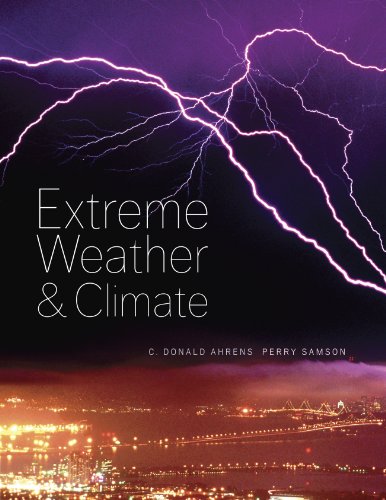Description
Extreme Weather Climate 1st Edition Ahrens Samson -Test Bank
Chapter 3
Temperature and Humidity Extremes
Multiple Choice Exam Questions
1. The maximum in daytime surface temperature typically occurs _______ the earth receives its most intense solar radiation.
a. before
b. after
c. exactly when
ANSWER: b
2. Radiational cooling typically occurs:
a. during the afternoon.
b. at night.
c. during the late morning.
ANSWER: b
3. The strongest radiation inversions occur when:
a. skies are overcast.
b. skies are partly cloudy.
c. skies are clear.
d. precipitation is falling.
ANSWER: c
4. During the afternoon the greatest temperature difference between the surface air and the air several meters above occurs on a:
a. clear, calm afternoon.
b. clear, windy afternoon.
c. cloudy, calm afternoon.
d. cloudy, windy afternoon.
ANSWER: a
5. The greatest variation in daily temperature usually occurs:
a. at the ground.
b. about 5 feet above the ground.
c. at the top of a high-rise apartment complex.
d. at the level where thermals stop rising.
ANSWER: a
6. The lowest temperature is usually observed:
a. at the time of sunset.
b. near midnight.
c. several hours before sunrise.
d. around sunrise.
e. several hours after sunrise.
ANSWER: d
7. In clear weather the air next to the ground is usually __________ than the air above during the night, and __________ than the air above during the day.
a. colder, warmer
b. colder, colder
c. warmer, colder
d. warmer, warmer
ANSWER: a
8. Suppose yesterday morning you noticed ice crystals (frost) on the grass, yet the reported minimum temperature was only 35o F. The most likely reason for this apparent discrepancy is that:
a. temperature readings are taken in instrument shelters more than 5 feet above the ground.
b. the thermometer was in error.
c. the newspaper reported the wrong temperature.
d. the thermometer was read before the minimum temperature was reached for that day.
e. the thermometer was read incorrectly.
ANSWER: a
9. At what time during a 24-hour day would a radiation temperature inversion best be developed?
a. at sunset
b. near sunrise
c. toward the end of the morning
d. between 2 and 5 pm when the air temperature reaches a maximum
ANSWER: b
10. The primary cause of a radiation inversion is:
a. infrared radiation emitted by the earth’s surface.
b. infrared radiation absorbed by the earth’s surface.
c. solar radiation absorbed by the earth’s surface.
d. solar radiation reflected by the earth’s surface.
e. infrared radiation absorbed by the atmosphere and clouds.
ANSWER: a
11. In a hilly region the best place to plant crops that are sensitive to low temperatures is:
a. on the valley floor.
b. along the hillsides.
c. on the top of the highest hill.
d. in any dry location.
ANSWER: b
12. An important reason for the large daily temperature range over deserts is:
a. there is little water vapor in the air to absorb and re-radiate infrared radiation.
b. the light-colored sand radiates heat very rapidly at night.
c. dry air is a very poor heat conductor.
d. free convection cells are unable to form above the hot desert ground.
e. the ozone content of desert air is very low.
ANSWER: a
13. Which of the following statements is/are true?
a. If you travel from Dallas, Texas to St. Paul, Minnesota in January, you are more likely to experience greater temperature variations than if you make the same trip in July.
b. Annual temperature ranges tend to be much greater near the ocean than in the middle of the continent.
c. If two cities have the same mean annual temperature, then their temperatures throughout the year are quite similar.
d. all of the above are true
ANSWER: a
14. The largest annual ranges of temperatures are found:
a. at polar latitudes over land.
b. at polar latitudes over water.
c. at middle latitudes near large bodies of wate.r
d. at the Equator.
e. in the Northern Central Plains of the United States.
ANSWER: a
15. Over the earth as a whole, one would expect to observe the smallest variation in temperature from day to day and from month to month:
a. at the North Pole.
b. in the center of a large land mass.
c. along the Pacific coast of North America.
d. high in the mountains in the middle of a continent.
e. on a small island near the equator.
ANSWER: e
16. Referring to Table 3.3: The air temperature is 45o F, the wind is blowing at 30 MPH, and the wind

Be the first to review “Extreme Weather Climate 1st Edition Ahrens Samson -Test Bank”